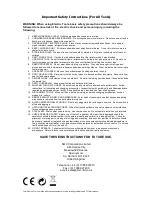
472-2776 Variable Speed Drill Kit
Please read these operating and safety instructions carefully before use.
Drill Specification
Voltage
12V DC
Chuck Type
keyless
Chuck capacity
0.4 - 3.2mm
Cable length
1.8m
Weight of drill
125g
This electric tool complies with E.C. requirements in force relating to radio and TV interference.
Applications
Your new high torque drill has been specially designed for close-up precision work in confined spaces. It is supplied with 30
accessories and a variable speed transformer. The drill will enable you to carry out a variety of jobs, including drilling, grinding,
sanding, cutting etc. in a multitude of applications such as hobby work, electronics, D.I.Y etc.
Sources of Power
Your drill has a 12V motor which makes it safer and smaller than a mains powered drill. A transformer/rectifier is needed to step down
the voltage to 12V (
RS
stock no. 472-2776 is supplied with a transformer).
Mounting of Accessories
Your drill is supplied with a chuck. To insert or change accessories, hold the locking ring and undo the chuck or collet nut. Insert the
accessory shaft into the chuck or collet ensuring maximum shaft contact and then tighten up. (Do not use pliers)
Connecting your 12V Tool
IMPORTANT: When connecting your 12V tool to the transformer you need to be sure that the polarity is
correct. (Connect the (+) plug of the tool to the (+) output on the transformer)
You have been supplied with an adapter that can be used to allow the use of Minicraft 12V Tools with this
transformer.
Technical Specification
Primary Voltage
230V/50Hz
Secondary Voltage
13.5V DC
Output Max.
22VA
Speed Control Range
7,000-30,000 rpm
Cable length
2.0m
Weight
1.13kg
The transformer is fitted with an internal overload cut-off system with automatic reset. This overload cut-off system protects your unit
from current loading and overheating. If the transformer is overloaded the overload system will be activated and the neon indicator
light will go out.
What to do if the overload cut-off system is activated
1.
Any 12V tool connected to the transformer should be switched off.
2.
Disconnect the transformer from the mains and then leave for 10 minutes. This allows the transformer to cool off and the
overload system to reset.
3.
After the 10 minute cool off time has been reached the transformer can then be reconnected to the mains. If the LED
indicator re-lights this means the overload cut-off system is successfully reset and the transformer is now ready for use.
General useful hints
1. The drill will become warm after a certain period of constant working and should therefore be periodically switched off and allowed
to cool down.
2. The motor does not require maintenance, but the chuck and spindle should be oiled now and then to ensure smooth operation.
3. To ensure concentric drilling, it may be necessary to re-insert the drill bit into the chuck 2 to 3 times whilst turning it slightly. A
certain amount of practice is required to achieve this alignment.
4. Never apply too much radial pressure to accessory bits while grinding, cleaning or polishing. By doing so you will put a strain on the
bearing and spindle, adversely affecting the precision of the drill.
5. The efficiency of the drill will be impeded by overloading and in many cases this will reduce its
performance. Always work with a sensitive touch; you have a precision instrument in your hands.
6. When drilling into metal, mark the drilling point with a centre punch first, so the drill tip does not slip.
7. Always ensure that there is maximum contact between the accessory shaft and the chuck.
For your safety
a. Always wear safety glasses.
b. If you stall the drill, turn it off immediately.
c. The tool should be unplugged when changing accessories.
d. Periodically check collet nuts and chucks for tightness especially during prolonged use of the same accessory.
e. If the transformer overloads, switch off and unplug the transformer from the mains. A short period of cooling time should be allowed
(approx. 3 minutes) in order for the overload system to automatically reset. Work can then be continued.
Please now take the time to read the general safety instructions set out on the reverse
of this page




















